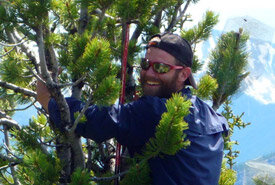Adrian Leslie: Whitebark Pine Ecosystem Restoration
On June 23rd, 2021, Adrian Leslie from the Nature Conservancy of Canada came to the Rossland Museum to talk about whitebark pine ecosystem restoration. Adrian discussed whitebark pine ecology and restoration in the West Kootenays. Whitebark pine is a keystone species that plays a critical role in subalpine ecosystems in the mountains around Rossland. It is also a species at risk due largely to White Pine Blister Rust, a non-native fungus that is decimating the species. Learn about whitebark pine ecology, restoration projects, and how you can help recovery efforts and be a part of a vibrant future for the whitebark pine in BC as you play in the great outdoors!
ABOUT ADRIAN LESLIE:
Adrian Leslie, Darkwoods project manager (Photo by Adrienne Shaw)
Adrian Leslie is a Registered Professional Biologist with a focus on high elevation whitebark pine ecosystem restoration. He is the project manager of the Darkwoods Conservation Area with the Nature Conservancy of Canada. He started out on this career path by working for Parks Canada as he was going through school; first, a forestry diploma, then a natural resource science degree, followed by a master’s degree in environment and management. He has experience working in both terrestrial and aquatic ecosystems from low elevation floodplains to high elevation forests throughout the Columbia Basin. For the past 15 years, he has been focused on terrestrial ecosystem research and restoration with a focus on forest health issues, fire ecology and climate change adaptation. To be the manager of the Darkwoods property is a dream come true for Adrian. To manage multiple watersheds that stretch from the tops of the mountains down to where the water reaches Kootenay Lake is a truly unique opportunity, and Adrian is dedicated to maintaining the natural beauty of the area and the full complement of species currently on the property by using the best available science to help guide the ecosystem through challenges associated with climate change.
“Adrian says: “The key thing that people can do to help is to identify and record locations of whitebark pine while in the subalpine. iNaturalist is best for this – identify a whitebark pine there, and I will have immediate access to that data. Location is important, but also information on how many mature trees there are and how big the stand is, and take lots of photos! This is critical in identifying potential sites for collecting cones for restoration. With all the fires going on right now, there will be a need for more seeds to be collected!” ”
How to Identify the Whitebark pine (Pinus albicaulis):
Whitebark pines can be identified by 3 distinct characteristics!
Photo from the US Forest Service
Needles = grow in bundles of 5.
Cones = the Whitebark pine has egg-shaped seed cones (5-8 cm long by 4-6 cm wide) which are dark brown to purple and remain on the tree unless removed by animals. The seeds are large for a pine at 7-11 mm long (about the size of a pea), chestnut brown and wingless. They are high in protein and several wildlife species rely on the seeds for food, notably the Clark’s nutcracker, but also the red squirrel, grizzly and black bear. Whitebark pine cones do not open on their own for seed dispersal. Instead, Clark’s nutcrackers use their long, pointed beaks to break apart the large cones and remove the seeds. The birds cache the seeds just under the soil surface to ensure a reliable source of food for winter. They use nearby rocks and wood debris to remember where the seeds are when needed. Roughly half the seeds are overlooked and many of these germinate and grow into pine seedlings.
Shape = when looking at a high elevation treeline, the whitebark pines look like they have “broccoli” or irregular shaped tops as opposed to the pointy “carrot” tops of other high elevation species. Whitebark pines are typically 5-20m tall, grow very slowly, and can live a very long time.
Things we can do to support whitebark pines:
Join iNaturalist and upload photos when and where you find whiebark pines! One of the world’s most popular nature apps, iNaturalist helps you identify the plants and animals around you. Get connected with a community of over a million scientists and naturalists who can help you learn more about nature! What’s more, by recording and sharing your observations, you’ll create research quality data for scientists working to better understand and protect nature. iNaturalist is a joint initiative by the California Academy of Sciences and the National Geographic Society.
Video Recording of the Presentation:
Slideshow:
Adrian developed a slideshow to accompany his presentation. Click the image below to see the slideshow images.
Other useful sources:
Whitebark Pine Ecosystem Foundation of Canada
Nature Conservancy of Canada - Whitebark Pine
BC Tree Index - Whitebark Pine
Header photo from the Nelson Daily Times, June 21, 2019. “Nature Conservancy of Canada adds 7,900 hectares to the Darkwoods Conservation Area in BC’s South Selkirk Mountains.” — Photo courtesy Steve Ogle.



